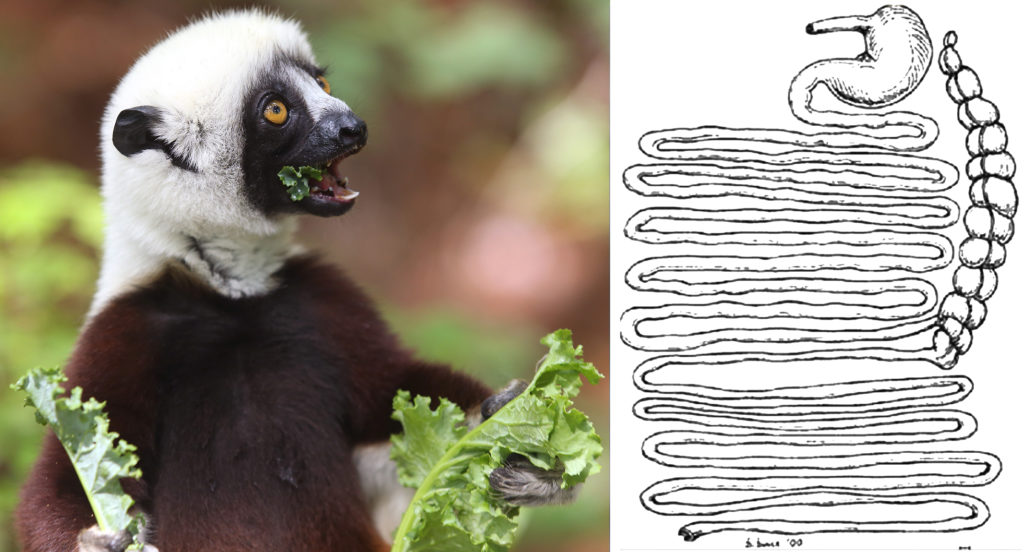By DLC Research Scientist Lydia Greene, Ph.D.
Follow Lydia on Instagram! @lemurscientist

Photo of Calpurnia, a Coquerel’s sifaka, by Bob Karp. Diagram reproduced from Campbell et al. 2000. Description of the gastrointestinal tract of five lemur species: Propithecus tattersalli, Propithecus verreauxi coquereli, Varecia variegata, Hapalemur griseus, and Lemur catta. American Journal of Primatology. 52: 133-142.
Sifakas eat foliage and seasonal fruits (1). Their gastrointestinal systems are designed to optimize nutrient extraction from both. Sifakas have an elongated gut tract that is an astonishing 14-15x their body length (2). Food takes about 24-36 hours to go from eating to excreting (3). I could tell you tomorrow what a sifaka ate last night.
Sifaka small intestines are 9x body length, which provides space to absorb fruit sugars and fats (4). Sifakas also have an enlarged cecum — the structure seen here that looks like a rattlesnake’s tail — which is another 1x body length (4). The cecum is essentially an overgrown appendix and the powerhouse of microbial metabolism. In the cecum, gut microbes ferment tough leaf fibers into nutrients, degrade plant toxins, release plant proteins from the leaf matrix, and synthesize vitamins not available in the lemurs’ diets.
Although fruit is a natural part of sifaka diets in Madagascar, we restrict their fruit access at the DLC. Orchard fruits are different from wild fruits: They’re rich in sugar and limited in fiber (5), which can throw off the delicate balance in the sifakas’ gut tract. We instead feed our sifakas lots of orchard vegetables, which are a better approximation of wild fruits (5): Kale, collards, broccoli, cauliflower, cucumber, carrots, corn, and sweet potatoes are all favorites.
References
(1) Sato et al. 2016. Dietary Flexibility and Feeding Strategies of Eulemur: A Comparison with Propithecus. International Journal of Primatology. 37: 109-129.
(2) Campbell et al. 2000. Description of the gastrointestinal tract of five lemur species: Propithecus tattersalli, Propithecus verreauxi coquereli, Varecia variegata, Hapalemur griseus, and Lemur catta. American Journal of Primatology. 52: 133-142.
(3) Campbell et al. 2004. Characterizing gastrointestinal transit time in four lemur species using barium‐impregnated polyethylene spheres (BIPS). American Journal of Primatology. 64: 309-321.
(4) Powzyk & Mowry. 2003. Dietary and Feeding Differences Between Sympatric Propithecus diadema diadema and Indri indri. International Journal of Primatology. 24: 1143-1162.
(5) Schwitzer et al. 2009. Fruits as foods–common misconceptions about frugivory. Zoo animal nutrition IV: 131-168.
Figure reproduced from: Campbell et al. 2000. Description of the gastrointestinal tract of five lemur species: Propithecus tattersalli, Propithecus verreauxi coquereli, Varecia variegata, Hapalemur griseus, and Lemur catta. American Journal of Primatology. 52: 133-142.

